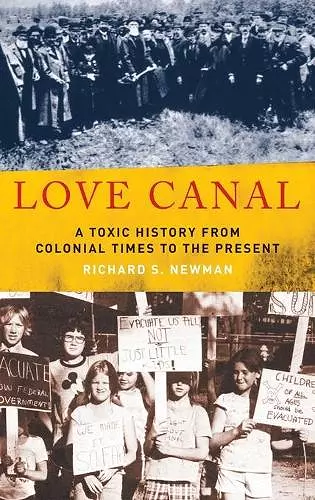Love Canal
A Toxic History from Colonial Times to the Present
Format:Hardback
Publisher:Oxford University Press Inc
Published:26th May '16
Currently unavailable, and unfortunately no date known when it will be back
This hardback is available in another edition too:
- Paperback£25.99(9780190053840)

In the spring of 1978, citizens of Love Canal, a suburban development in Niagara Falls, NY, began protesting against the leaking toxic waste dump -- a sixteen acre site containing 100,000 barrels of chemical waste -- upon which their homes, elementary school, and backyards stood. The Love Canal citizens' movement represented a different brand of environmental reform. Rather than focusing on resource conservation and preservation of natural spaces, Love Canal reformers advocated environmental justice. By the early 1980s, hundreds of local activists (many of them self-described "housewives-turned-activists") had forced two important initiatives from politicians and business leaders: government relocation of Love Canal families and government/industry remediation of the dump itself. Love Canal activists also spurred passage of the Superfund law at the federal level, "Right to Know" statutes at the state level, and a wave of copycat citizen-environmentalist groups in communities across the country (so-called NIMBYs: "Not In My Backyard" environmentalists). Nearly thirty years after making international headlines, Love Canal remains a watchword of hazardous waste reform and one of the most significant environmental disasters in American history. In this book, Richard S. Newman examines this oft-told event within the wider context of the landscape through five centuries. He begins with the conflicts that erupted between the resident Iroquois and French explorer Rene Lasalles' commercial development schemes in the Niagara Falls region. During the 18th and 19th century, the Love Canal landscape was transformed by successive generations of European and American entrepreneurs and industrialists. Love's Canal was the dream of William Love, a developer who in 1893 planned a massive industrial metropolis to be carved out of the Niagara region's lush farmland, capped by an artificial river with a waterfall higher than Niagara Falls. His scheme failed but not before digging of the canal had begun. The scheme attracted the interest of famous conservationists like John Muir, Theodore Roosevelt, and John Burroughs, who argued for preserving the falls from commercial and industrial overuse. Yet throughout the twentieth century the area supported massive industrial growth, including that of the Hooker Electrochemical Corporation, the company that dumped industrial chemicals into the abandoned Love Canal site. As the company grew, its efforts to handle disposal of its hazardous waste led to development of a new process of "in-ground...
[T]his legacy of Love Canal may provide redemption and hope. * Amy M. Hay, The Journal of American History *
Newman's narrative is more complete than any that has come before. He makes excellent use of rich source material * David Stradling, American Historical Review *
Richard S. Newman, in his Love Canal: A Toxic History from Colonial Times to the Present, manages to retell the story in a way that is fresh and imbues Love Canal, as place and symbol, with new importance for understanding the history of citizen activism, environmentalism, and environmental regulation in the United States ... essential reading. * Cody Ferguson, Environmental History *
- Winner of Winner of the Malott Prize for Recording Community Activism of The Langum Charitable Trust.
ISBN: 9780195374834
Dimensions: 239mm x 155mm x 25mm
Weight: 590g
328 pages